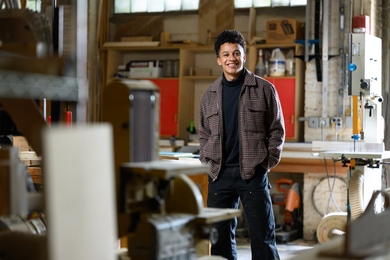Three MIT inventions and a fourth resulting from an MIT-industry collaboration are finalists in the 1998 Discover Magazine Awards for Technological Innovation.
The principal researchers for each will receive all-expense-paid trips to an awards gala June 6 at Walt Disney World, where the overall winners in each of nine categories will be announced. All finalists will also be profiled in Discover magazine.
Almost 4,000 innovators were invited to apply for the 1998 awards. The 44 finalists are distributed among the following categories: automotive and transportation, aviation and aerospace, computer hardware and electronics, computer software, environment, sound, sight, robotics and emerging technology (any promising new innovation or technology that, by virtue of its "newness," does not fit into any of the other categories).
The MIT researchers, their inventions and award categories are listed below.
ATOM LASER
Professor Wolfgang Ketterle, Department of Physics, atom laser, emerging technology. "An atom laser does for atoms what an optical laser does for light," wrote Professor Ketterle in his application for the award. "It generates an intense beam of coherent atoms. The step from ordinary atomic beams to atom lasers is analogous to the step from the lightbulb to the optical laser."
Asked to describe how the innovation will benefit the average consumer or the public in general, he wrote: "The atom laser might replace conventional atomic beams where ultimate precision is required, e.g., in atomic clocks and for tests of the fundamental laws of physics. Ultimately, [it] might lead to high-resolution atom deposition on surfaces for the fabrication of novel materials and nanostructures."
PENGUIN BOAT
Professor Michael Triantafyllou, Department of Ocean Engineering, Proteus the penguin boat, automotive and transportation. "Proteus is the first high-efficiency flipper-propelled model boat. It is being used to demonstrate the advantages in propulsion and maneuvering offered by this novel biomimetic propulsion mode," Professor Triantafyllou wrote.
"By reducing shipping costs through improved efficiency, less fuel will be used and less environmental pollution will result. If this innovation can be manufactured in the United States, it can revitalize the US shipbuilding industry."
QUANTUM COMPUTER
Associate Professor Neil A. Gershenfeld, Physics and Media Group, Media Laboratory, molecular quantum computer, emerging technology. Classical computers are going to reach physical limits within a few decades beyond which they cannot be clocked any faster or shrunk any smaller. Quantum mechanics holds out the promise of still faster computers, but until now no one has been able to solve the paradox of interacting with a quantum computer while still keeping it isolated.
Professor Gershenfeld and his colleagues have found a solution in a solution, by computing with the nuclei of molecules in a liquid. Using this technique, they have demonstrated computations using fewer steps than a classical computer would require, and are now developing a prototype tabletop quantum computer.
TRUEPOSITION
MIT researchers were also key to a fourth Discover Award finalist: the TruePosition Wireless Location System. This system, a finalist in the computer software category, can locate callers from mobile phones within seconds.
As a result, "public safety officials can now immediately pinpoint the location of wireless emergency 911 callers and quickly dispatch emergency response units to the right location to aid victims," wrote Louis A. Stilp of TruePosition, Inc., in his award application. Research has shown that "over 3,000 lives could be saved annually if emergency response teams could reach automobile accident victims just nine minutes faster than they do today."
Research on the TruePosition technology began in 1992, but since 1995 it's been a team development between TruePosition and MIT's Haystack Observatory. Alan E. Rogers, associate director of Haystack, led the Haystack team.
A version of this article appeared in MIT Tech Talk on April 29, 1998.





